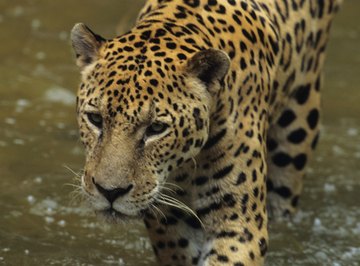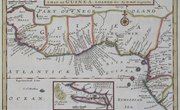
The elusive, powerful, strikingly colored jaguar (Panthera onca) is the largest feline of North and South America. Formerly it ranged from the southeastern United States to the tip of South America. Now restricted in distribution because of human activities, such as hunting and clearing of land for agriculture, building and grazing, jaguars live mostly in Mexico, Central America and Brazil. Although jaguars can live in scrub and deserts, they need fresh water in their habitat, and are commonest in rainforests, savannahs and swamps.
Hot and Humid Rainforests
Grouped around the Equator, tropical rainforests of Brazil and Central America contain dense tree cover with layered understories, high temperatures and high humidity. Temperatures rarely go below 20 degrees Celsius (68 degrees Fahrenheit) and average around 32 degrees Celsius (90 degrees Fahrenheit). Humidity can be as high as 90 to 95 percent, but is usually around 80 percent. The Amazon Basin has a climate that doesn't vary much through the year, with balmy days and short, heavy rainfalls averaging three to four days a week. (see Reference 2, page 7, Rainfall) Average annual precipitation varies from 250 cm (98 inches) to 400 cm (157 inches). Brazilian rainforest jaguars rely on mammals for 87 percent of their diet, predominantly long-nosed armadillo and white-lipped peccary. Reptiles comprise 9.8 percent and birds 2.8 percent of their food.
Savannahs
Savannahs are natural grasslands that contain low-density scrub and trees. The savannahs in South America's Gran Chaco have viable jaguar populations. The Gran Chaco, which experiences heavy flooding, covers parts of Bolivia, Paraguay, Argentina and northern Brazil. Savannah winters are cold and dry with some frost. Summers are hot and rainy, with the Gran Chaco known as one of the hottest places in South America.
Swamps
The largest continental wetland in the world is South America's Pantanal, which means swamp or marsh in Portuguese. This prime jaguar habitat occurs in the Brazilian states of Mato Grosso and Mato Grosso do Sul and parts of Paraguay and Bolivia. The largest jaguars in the world live in the Pantanal. In the wet season from November to March, 80 percent of the land floods, with water as high as 3 meters (10 feet). January or February sees the highest flooding, although the heaviest rain comes in February and March. The dry season is in April or May through September or October, with the hottest temperatures, which can exceed 40 degrees Celsius (104 degrees Fahrenheit), occurring in November and December. Jaguars have been documented catching caimans, which resemble alligators, for food in the Pantanal.
Deserts and Scrublands
Jaguars were thought hunted to extinction in the northernmost parts of their original range, consisting of Madrean evergreen woodland and semi-desert scrub grasslands of the United States and Mexican borders. However, four or possibly five adult jaguars thought to be resident were documented in southern Arizona since 1996. (see Reference 9, Distribution and Habitat) The weather in these ecosystems consists of cool to cold winters and hot summers. Annual average rainfall is about 37 cm (14.7 inches), with more than 52 percent falling during summer monsoons. In higher elevations, some winter precipitation occurs as snow.
References
- Big Cat Rescue: Jaguar Facts
- Bradt Travel Guide the Amazon: The Bradt Travel Guide; Roger Harris, Peter Hutchison
- Biotropica: Jaguar (Panthera onca) Food Habits in Atlantic Rain Forest of Southeastern Brazil
- Wildlife Conservation Society: Gran Chaco, Bolivia & Paraguay
- Tropical Grasses; P. J. Skerman, Fernando Riveros
- Panthera: Pantanal Jaguar Project
- Lonely Planet: The Pantanal: Weather
- San Diego Zoo: Jaguar, Panthera Onca
About the Author
Carolyn Csanyi began writing in 1973, specializing in topics related to plants, insects and southwestern ecology. Her work has appeared in the "American Midland Naturalist" and Greenwood Press. Csanyi holds a Doctor of Philosophy in biology from the University of Wisconsin at Madison.
Photo Credits
Tom Brakefield/Stockbyte/Getty Images
